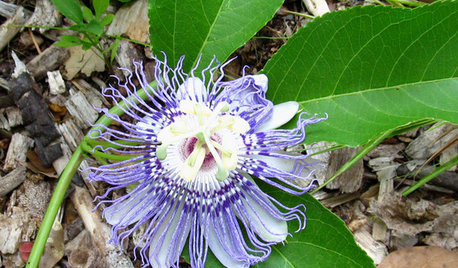passion fruit...what strains self pollinate?
sunseeker1001
15 years ago
Related Stories

GARDENING GUIDESGreat Design Plant: Passiflora Incarnata
Enjoy the amazing flowers and edible fruit of U.S. native Passiflora incarnata (also known as maypop) — the butterflies sure do
Full Story
FARM YOUR YARDHello, Honey: Beekeeping Anywhere for Fun, Food and Good Deeds
We need pollinators, and they increasingly need us too. Here, why and how to be a bee friend
Full Story
GARDENING GUIDESAttract Hummingbirds and Bees With These Beautiful Summer Flowers
Roll out a welcome mat for pollinators to keep your landscape in balance and thriving
Full Story
GARDENING GUIDESLush, Foodie Abundance in a Small Urban Garden
This modest backyard garden provides its owner with fruit and vegetables all year round, thanks to an innovative low-maintenance approach
Full Story
LANDSCAPE DESIGNHow to Create a Cottage-Style Garden
If you like an abundance of plants — and visits from birds, bees and butterflies — this may be the style of yard for you
Full Story
GARDENING FOR BUTTERFLIESGardening for the Bees, and Why It’s a Good Thing
When you discover how hard bees work for our food supply, you may never garden without them in mind again
Full Story
GARDENING GUIDES6 Plants That Beat Butterfly Bush for the Wildlife Draw
It's invasive, a nonnative and a poor insect magnet. Check out these better alternatives to butterfly bush in the garden
Full Story
GARDENING GUIDESLessons in the Rewards of Selfless Gardening
Let go of gardening for your own vision and watch the garden’s own true vision come forth
Full Story
SUMMER GARDENINGHouzz Call: Please Show Us Your Summer Garden!
Share pictures of your home and yard this summer — we’d love to feature them in an upcoming story
Full Story
FEEL-GOOD HOME21 Ways to Waste Less at Home
Whether it's herbs rotting in the fridge or clothes that never get worn, most of us waste too much. Here are ways to make a change
Full Story





mark4321_gw
sunseeker1001Original Author
Related Professionals
Benbrook Landscape Architects & Landscape Designers · Coram Landscape Contractors · Fairview Landscape Contractors · Fort Worth Landscape Contractors · Waipahu Landscape Contractors · Waterford Landscape Contractors · Tyngsboro Landscape Contractors · Fort Worth Driveway Installation & Maintenance · Grand Rapids Driveway Installation & Maintenance · Redford Driveway Installation & Maintenance · Riverside Driveway Installation & Maintenance · Murraysville General Contractors · Hammond General Contractors · Langley Park General Contractors · Parma General Contractorsmark4321_gw
sunseeker1001Original Author
mark4321_gw
sunseeker1001Original Author
cyrus_gardner
mark4321_gw